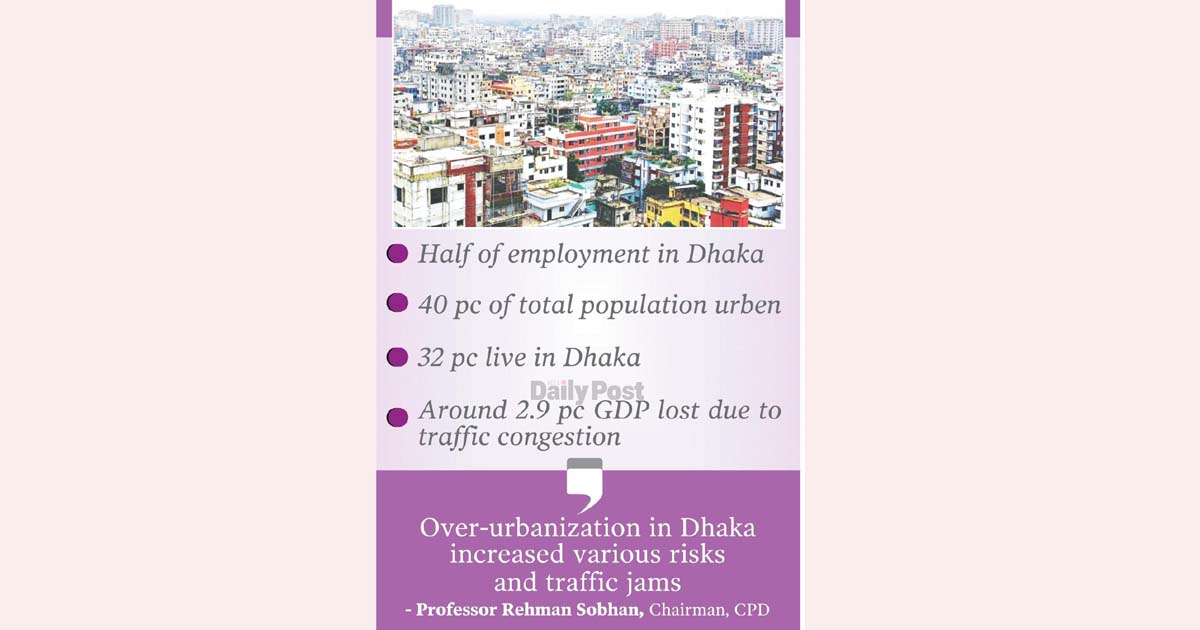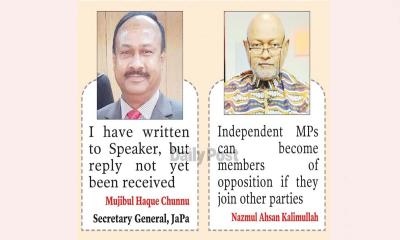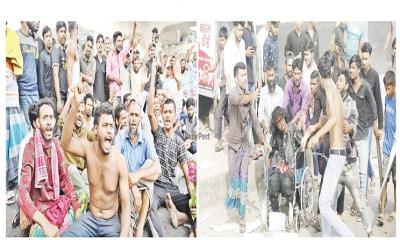In the whole country in 1997, the urban area was only 9 percent. It has increased manifold to nearly 40 percent in 2022. That is, in the last 48 years, the amount of urban areas in the country has increased by about 31 percent. Although the size of the urban area is increasing the roads are not corresponding to it. Where 25 percent of the total area is supposed to be roads, there is only 8 percent. Moreover, 52 percent of motor vehicles are impassable. And because of these reasons, the traffic jam are constantly increasing, this is what comes out in the joint research of Bangladesh Poribesh Andolon (BAPA) and Bangladesh Environment Network (BEN). BEN and BAPA's research shows that the green and aquatic parts of
the country's cities are disappearing due to continuous encroachment and pollution. 40 percent of the country's population now lives in cities; Among them, 32 percent of city dwellers live in Dhaka. By 2041, 50 percent of the country will be urbanized. Although the government has announced the creation of developed countries, the projects that developed countries are withdrawing from are being implemented in Dhaka. Unplanned projects are being implemented in Dhaka with huge amounts of money, and other cities of the country are also demanding those projects. The whole country follows Dhaka. Most of these projects are not mass-oriented, some projects are only considered for the middle class and upper class. The government has to move away from these activities and implement people-oriented projects, then it will be environment friendly. Not just a few cities, but the 64 districts of the country must work seriously.
The study also shows that one-third of the GDP comes from Dhaka and almost half of the country's employment is in Dhaka alone. But Dhaka does not have minimum civic facilities. The benefits of investment in Dhaka are less than the investment in the district and upazila. In this, the GDP is reduced by 6 to 10 percent. Dhaka's overgrowth is damaging the economy of the entire country. It has become difficult to meet the needs of various basic civic services ie electricity, water, sewerage, roads, transport, and shelter of the city dwellers. Income inequality among the people of the country has increased more than before. 18 percent of the country's total income is in the hands of 50 percent of the poor. And the richest 5 percent have 30 percent of the total income. The government has announced the transformation of villages into cities but has not given specific outlines.
According to experts, investment in Dhaka has been increasing since the eighties. Before this, investments were made in Dhaka like other cities. At that time there was not much difference between Dhaka and other cities of the country. After more investment, employment in Dhaka continues to increase. People from different parts of the country started gathering in Dhaka for the need of work. The rate at which the investment towards Dhaka increased, the investment in the district and upazila cities did not increase at that rate. As a result, Dhaka has become a densely populated city. Now the speed of vehicles has come down from 23 km to 7 km. About 2.9 percent of GDP is affected due to traffic congestion in Dhaka. According to Census 2022 data, Dhaka North City has about 31,000 people per square kilometer. And in Dhaka South City, about 40 thousand people live per square kilometer. The population of the capital Dhaka is constantly increasing. Focusing on urbanization, everyone is moving towards the capital. But roads and facilities are not increasing accordingly.
Bangladesh Environment Network (BEN) founder president and Bapar vice president Dr. Nazrul Islam said that the government has given importance to the creation of 100 economic zones. It is a good initiative, if not altogether, at least 1 economic zone will be established in 64 districts, which will also increase district-wise employment. The flow of people towards Dhaka will decrease. Although Dhaka was supposed to be an administrative and residential city, the city has turned into an industrial city due to unplanned land use. About 40 lakh workers are working in the garment sector in Dhaka and surrounding areas. I will demand that the new government, think again about the urban planning of the country. Otherwise, the growing urban areas of the country will create major problems, which cannot be managed. At present, there are 12 city corporations, 327 municipalities, and 570 urban centers in the country.
Professor Nazrul Islam, Chairman of Urban Research Center, said that 500,000 people are being added to Dhaka every year; About 4 lakh of them are poor. Overgrowth is troubling the city. The government has no sense of responsibility for urban development. Although the rural country is in the race to become a city-state, there is no urban development ministry in the country. Initiatives were taken to build large residential areas in Mirpur for the poor. 20 times more people live there than planned. No problem there though. Because the work was done there in a planned way. Dhanmi and Mohammadpur residential areas were built for the elite at that time. Government planning should include the poor.
Chairman of the Center for Policy Dialogue (CPD) Prof. Rehman Sobhan said traffic congestion has increased as a result of over-urbanization in Dhaka. Various types of risks are increasing in the city. Urban speed is increasing due to a lack of coordination. The people of the country are getting hungry due to the flashy advertisements of housing companies. He said that housing companies have filled the area around Dhaka and built projects. Government agencies have failed to play a proper role in controlling these. For this reason, I will request the government to look into the earthquake prevention system of the city-related people and related people. In developed cities around the world, including New York, mayors wield a lot of power. That is why they can play a big role in urban development and control. The power of the mayors of Bangladesh needs to be increased. Then they can do things properly.
ARS







